Stuck on how to Fix CashLoopBackOff Kubernetes Error? Here’s a simple instruction that actually helps you fix it, with real commands and steps. Our Kubernetes Support Team is always here to help you.
Fix CrashLoopBackOff Kubernetes Error
The CrashLoopBackOff Kubernetes error is one of those issues you don’t want to see in production. It means your container keeps crashing, and Kubernetes is stuck trying to revive it, unsuccessfully. No fluff, no jargon, here’s how to fix CrashLoopBackOff Kubernetes error without wasting time.
Once you spot it, the clock starts ticking. Let’s get you to the solution. These are the exact checks and actions you need to take.
An Overview
1. Look at the Container Logs First
Your first move to Fix CashLoopBackOff Kubernetes Error
should be be checking what your container is screaming about before it dies. Logs will often tell you the root cause.
$ kubectl logs <pod-name> <container-name>Check for stack traces, permission issues, missing files, or service errors. This will almost always give you a good hint.
2. Dive into the Pod’s Configuration
Sometimes, a simple misconfiguration breaks everything. Use this to inspect the pod details:
$ kubectl describe pod <pod-name>You’ll find important clues here, image issues, pull errors, event warnings, and more. It’ll help you understand if something inside your manifest is off, like with IPAM cluster configurations.
3. Check for Resource Limits and Requests
Resource constraints are a silent killer. If your container tries to consume more memory or CPU than it’s allowed, Kubernetes kills it. Again, this command does the job:
$ kubectl describe pod <pod-name>Look under the Limits and Requests sections and confirm the container isn’t running out of juice, invalid capacity 0 on image filesystem is one such issue that can sneak in.
4. Verify Dependencies Are Available
Your container might be fine, but it could be depending on a database, service, or config that’s not there or misconfigured. Open a shell into the running container and poke around:
$ kubectl exec -it <pod-name> -c <container-name> shTest your connection to other services, ensure env variables are set, and files or binaries your app expects are present.
5. Fix Any Code-Level Issues
Sometimes it’s not Kubernetes, it’s your app. Review logs and behavior closely. Here’s a clean example of a basic Node.js HTTP server:
const http = require('http');
const server = http.createServer((req, res) => {
console.log('New request received');
res.end('Hello, World!');
});
server.listen(8080, () => {
console.log('Server started on port 8080');
});Make sure your app exits cleanly and doesn’t crash on startup. Tools like console.log, application-specific debuggers, and stack traces are your best friends here.
6. If Needed, Recreate the Pod
Once you’ve made changes, don’t wait around. Recreate the pod to force Kubernetes to spin up a new instance with the updated setup:
$ kubectl delete pod <pod-name>This triggers a fresh deployment and lets you observe if the problem is resolved right away.
[If needed, Our team is available 24/7 for additional assistance.]
Conclusion
There’s no magic wand here. To fix CrashLoopBackOff Kubernetes error, you go through logs, check your setup, confirm resources, verify dependencies, and squash app bugs. Then restart and watch it go green.







0 Comments